In the opening cutscene of Persona 3 Reload, protagonist Makoto Yuki walks by someone with a Pride pin on their bag. The shot lingers for a few seconds, making it hard to ignore this detail, a new addition for this remake of Atlus’ 2006 role-playing game. The moment also ends up serving as a pretty decent encapsulation of how queerness is situated throughout this updated version of the 18-year-old classic. It is present, the player can’t miss it, but it ultimately doesn’t manifest in any queer relationships, and yet it remains a small reminder that things can be different moving forward. Persona 3 Reload didn’t let me date Akihiko Sanada, but it, alongside some key scenes in Persona 5 Tactica, has me more hopeful than ever that Persona might finally do right by its queer fans in Persona 6.

In most ways that matter, Persona 3 Reload faithfully retells the story of the 2006 original. Makoto, along with his teammates in the Specialized Extracurricular Execution Squad, are normal high school students by day and a shadow-hunting crew fighting supernatural monsters by night. In between studying and slaying, there’s a lot of meaningful relationship building among the crew, and if you so choose, you can follow those relationships down the path to romance. However, not since Persona 2 has the series had the option for you to pursue a same-sex relationship, though it’s complicated by the fact that elsewhere, that game also indulges in old-fashioned transphobia. In fact, the series has gone out of its way to alienate queer people at almost every turn in the games that followed.
Persona’s messy queer history
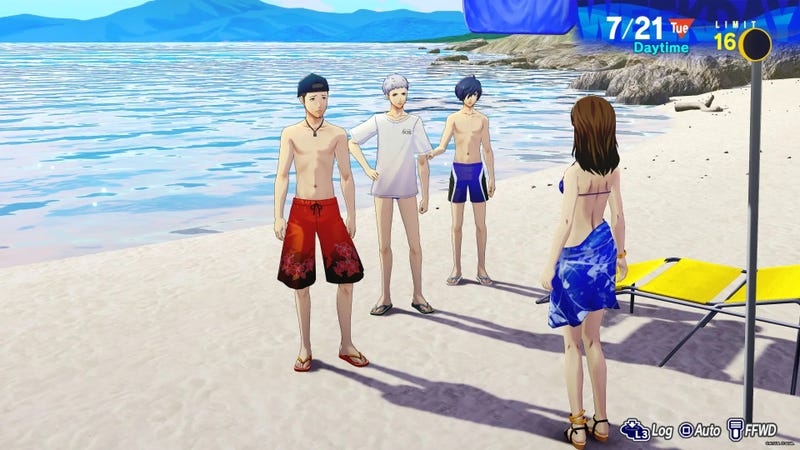
The original Persona 3 had an infamously transphobic scene that involved the team’s male party members doing some headass trans panic nonsense while unknowingly trying to pick up a trans woman on a beach. As we reported, this scene has been altered in Reload to no longer include transphobia, but as Inverse points out, the new scene misses an opportunity to better represent the trans experience without erasing her identity from the scene entirely. It’s easily a quantifiable improvement, but it never takes the next step from “not being shitty” to actually being a positive take on the subject matter.
Persona 4’s relationship to queerness is the messiest of all three of the “modern” Persona games. The game’s supernatural motif sees its cast of high school students confronting distorted “shadow” versions of themselves. These caricatures are meant to embody their various insecurities, which can be rooted in their identity, career trajectory, or how they relate to those around them. The “shadow” version of Kanji Tatsumi, a seemingly hypermasculine guy in a biker gang, manifests as an overly promiscuous gay man, in a dungeon that takes the shape of a men-only bathhouse.
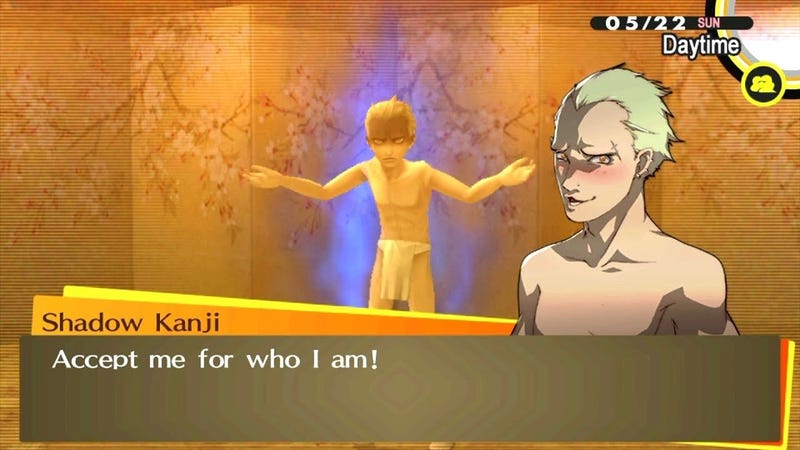
On paper, this is meant to tap into his insecurities regarding masculinity and perceived gender norms because he also loves to sew, knit, and create cute little plushies. He has a hard time reconciling his macho persona (no pun intended) with the things he actually loves. That in and of itself isn’t the problem with Persona 4’s perception of queerness. It’s the framing of a hypothetical queer identity as a phase to be grown out of or an anxiety to be shaken and discarded after you realize that you’re “just like everyone else.” The way forward for his story is to convince him that he’s not queer, he just likes cute shit. There’s no opportunity to advocate for the other possibility. This isn’t helped by his “friends’” outward homophobia that follows and the fact that no one goes so far as to defend Kanji, or gay people. The game’s class clown party member Yosuke, for instance, says he doesn’t know if he feels safe with a possible homosexual sharing a tent with him on a school camping trip.
Persona 4’s relationship with queerness is also complicated by Naoto Shirogane’s storyline. The detective party member originally presents as a man, but as the story progresses, it’s revealed that she’s actually a woman who has presented as a man because she’s obsessed with getting into the male-dominated field of solving crimes. (The character clearly expresses discomfort with her body at times as well, though.) Her character arc focuses on her becoming comfortable with her female identity, and the clumsiness with which it handles this has made the game a sore spot for trans fans over the years.

Naoto’s shadow manifests as a mad scientist who wants to perform an “operation” on her, which is heavily implied to be a gender-reassignment surgery. Again, Persona 4 asserts that this is tied to her internal feelings of womanhood conflicting with her career aspirations, but Naoto’s continued discomfort with femininity has meant the trans reading has stuck with the character since the game launched in 2008, and given that her storyline, much like Kanji’s, doesn’t allow you to support the other option, it further underlines Persona 4’s framing of these identity struggles as born of confusion above all else.
By the time Persona 4 Golden’s epilogue comes around, Naoto presents as a woman. But this follows Persona 4’s waffling back and forth between “these characters need to accept hard truths” and “these feelings you’re having are phases you will grow out of.” So Kanji never comes out as a gay man, Naoto no longer goes by the “Detective Prince” moniker. These relapses into old ways of thinking and being are how most of the party members’ stories end, and it’s only made more disappointing when it’s viewed through the queer lens.
Persona 5’s problems with queerness leave the messiness of Persona 4 behind in favor of the kind of queer panic seen in Persona 3. The game’s original release has a scene in which two unnamed gay men find party member Ryuji Sakamoto on the streets of Shinjuku and proceed to harass him, and it ends with an implied sexual assault. The Persona 5 anime adaptation then made it so there was nothing “implied” about it. With no explicitly queer relationships and a game-long commitment to never entertaining the possibility that the player could be gay outside of the occasional joke response, this scene is the only time Persona 5 really acknowledges the existence of queer people.
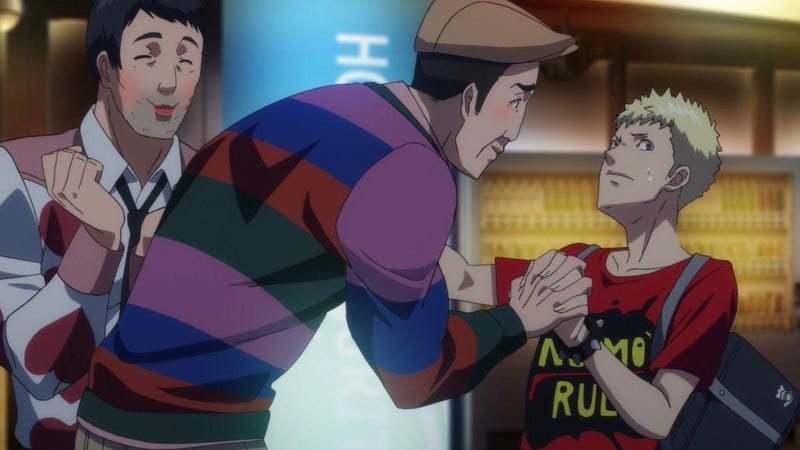
Localizers made an attempt to make the scene somewhat palatable in Persona 5’s definitive Royal re-release by changing the dialogue so the men are no longer outwardly predatory and are instead drag enthusiasts looking to show Ryuji the ropes. It maps well enough onto the same scene but at least doesn’t have the horrifying implication of assault at the end. It’s better, but still gives the most queerphobic person you know ammunition to paint gay men as predatory.
Meanwhile, the 3DS dungeon-crawler spin-off Persona Q: Shadow of the Labyrinth had a segment in which the Persona 3 and 4 protagonists could be nearly married to the male party members in a dungeon. But it was more played up for laughs, and the fact that they were forced into it doesn’t do it many favors. However, former homophobe Yosuke does seem to have had a change of heart, saying in one conversation, “Who cares if a guy looks at another guy? The problem comes when you freak out about it.”
Thankfully, things have started to gradually change. Persona 5 Tactica, the tactics RPG spin-off that launched last year, has a scene in which you, as protagonist Joker, can express romantic interest in male party members without it becoming a disparaging joke. It’s still working in the confines of Persona 5, so nothing actually comes of it. But after years of these games finding ways to be off-putting to queer people for no reason, it was refreshing to finally be able to ship Joker and Ryuji in the game without feeling like Atlus was going to slam the door in my face on the way in.
Despite enjoying that scene in Tactica, I didn’t carry any hope that Persona 3 Reload would take the next step and let me follow the game’s new social sim stories with male party members into a relationship. What hadn’t occurred to me is that Atlus would make some old characters explicitly queer. This happens twice in Persona 3 Reload, but neither of them actually leads to a gay relationship between Makoto and another guy.
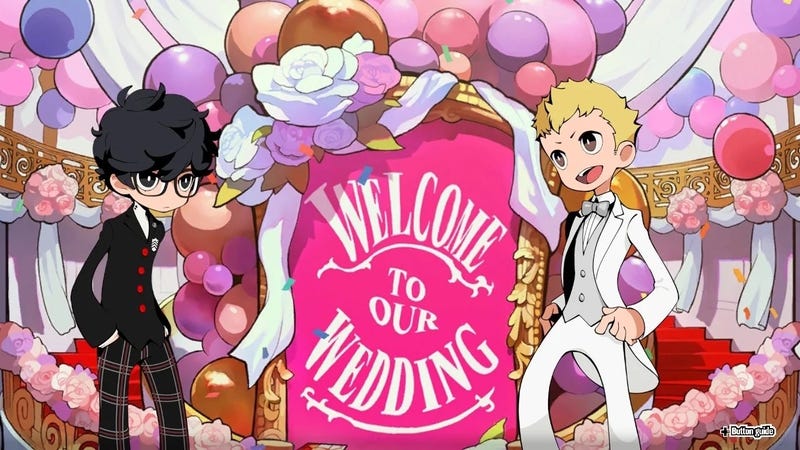
Persona 3 Reload has gay stories, but not romance
The first time this comes up is with Takaya, an antagonist and leader of the group Strega who wants to maintain the supernatural Dark Hour phenomenon the party seeks to end. This trio of Persona users are a thorn in SEES’ side throughout Persona 3, but Reload adds some new scenes that flesh out their backstory and give us more insight into their dynamics. This includes a scene in which Takaya is speaking with his lackey Jin, and expresses his fascination with Makoto and his ability to wield multiple Persona. Then after a moment of silence, he mutters to himself, “Am I feeling… attachment for someone…?” He maniacally laughs the thought away, considering it “beneath” him.
Later, when Takaya meets up with Makoto and they have an ideological clash, the villain says that Makoto’s clinging to his ideals of prioritizing the safety of his friends over continuing to use his Persona tramples on everything Strega stands for. But as his anger starts to reach peak levels, he shouts, “And worst of all, your rejection of my—” and then cuts himself off.
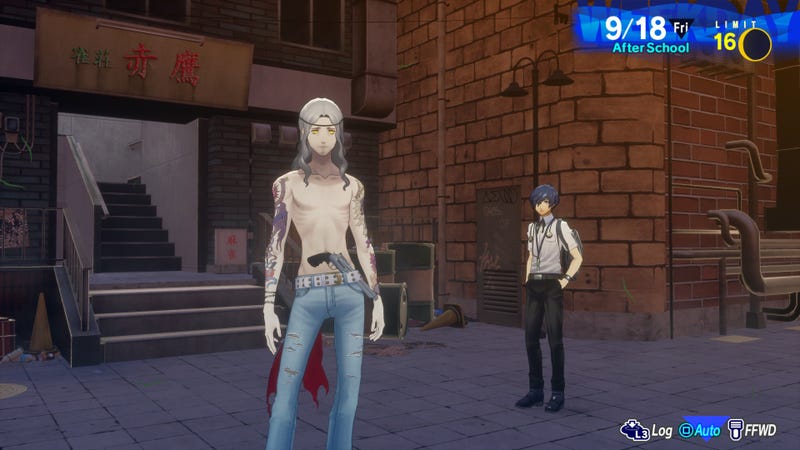
Inevitably, there will be those who say this proves nothing and isn’t explicitly Takaya admitting to having feelings for the protagonist. However, “attachment” is the clinical word Strega uses to describe romantic love, as demonstrated in later scenes between Strega member Chidori and party member Junpei. Their entire schtick is forsaking the ties that bind in order to see no value in life. This is the nihilistic framing Strega uses for everything, right down to the vernacular.
If Takaya wasn’t enough, the most explicit example of queer pining is between Makoto and Ryoji, an enigmatic student who transfers to SEES’ school near the end of the game. Without getting too in the weeds of who Ryoji is, he and Makoto have a connection that is pivotal to Persona 3’s story and is expanded upon in Reload. While he’s shown to be a ladies’ man who will flirt with every girl he comes across, when Reload is reaching its final act, he asks to meet in the school’s music room.
Here, he confesses, in no uncertain terms, that he wants something beyond friendship. Unfortunately, however, the game doesn’t take the next step of letting you express mutual interest. Ryoji’s confession is dripped in melodrama, so the fact that your potential responses are tinged with concern about how upset he seems to be fits the tone of the scene. But it’s still frustrating being unable to reciprocate when another guy is confessing his love for you.
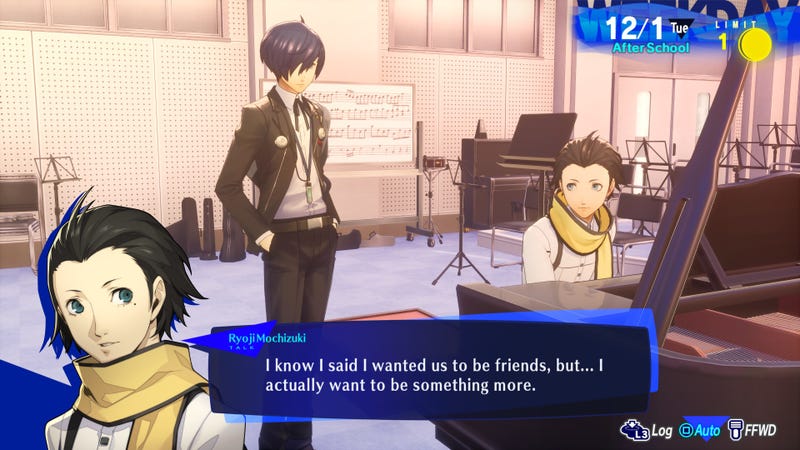
In a way, Takaya and Ryoji were the two characters Persona 3 Reload could add these layers to without drastically altering the source material. Their roles in the story mean any relationship with them would have been doomed to fail, so letting them be queer, in love with the protagonist, and also not romantic options is about the only way that could have gone down. This isn’t the radical next step the remake could have taken by giving players an Akihiko romance or even letting us date any of the other male social links we meet in the game, but it’s not nothing.
My natural inclination is toward disappointment, and there will likely be people who take issue with the two queer men who fall for the protagonist being a villain and evil-adjacent. Is it really “better” than making Persona 5’s sole explicitly gay characters predators if Persona 3 Reload’s gay characters are a cult leader and a monster? To that, I say queer characters do not need to be innocent, pure beings, and I prefer a complicated character with a vision than one that exists to be a shining beacon of queer goodness. There are plenty of other video games out there that have queer characters who occupy that space, and given the depths of both these characters, I’m not mad about that.
Persona 3 Reload is a start, but Persona 6 needs to take the next step
Still, I don’t want to give Atlus heaps of praise for just finding ways to write queerness into an old story in the least radical way possible, one that plays into old tropes about queer-coded villains. Having these characters and not making a mockery of them is the bare minimum. Most queer fans are likely tired of getting table scraps and aren’t going to be thankful for them after Atlus has kicked them in the face for asking for anything. But it does feel like a notable shift. Fans have pointed out that Persona 5 Tactica and Persona 3 Reload do not have the same creative leadership as past entries, some of whom have been working on Metaphor: ReFantazio. If shifts in personnel that see a younger generation take the reins have made Persona a more inclusive series, then I’m glad to see new blood getting the chance to re-evaluate an old text.
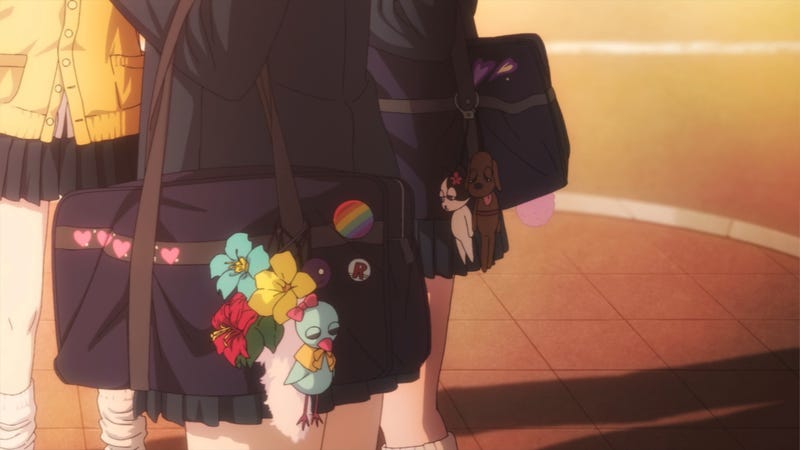
After years of loving Persona but feeling like it didn’t love me back, I’m not going to say the changes made in Persona 3 Reload exonerate Atlus for everything that’s happened in the years since the original launched in 2006. But I keep thinking about that Pride pin on that stranger’s bag at the beginning of the game. The Pride flag has been commodified over the years, but it still means something. It embodies decades of struggles, fights for progress, and safety for those looking for refuge from a world that is often unfriendly to them. If a Pride flag is featured so prominently this time around, perhaps this is a sign that the new team wantsPersonatobe safe for queer people, too.
Persona 3 Reload may not be the full step forward the series needs, but all these changes feel like a foundation to build something better. Persona 6 may still be years away, but between Reload and Tactica, I’m more hopeful than I’ve ever been that the series might be ready to do right by people it has historically pushed away. I hope I’m not wrong.
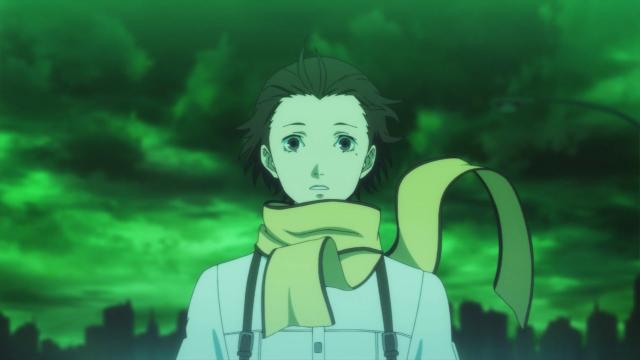
Leave a Reply